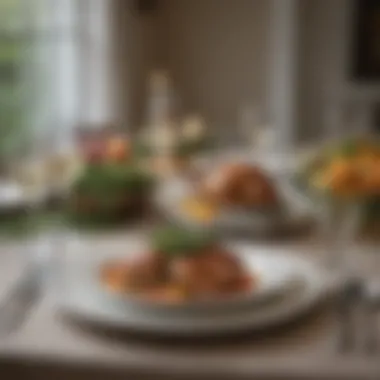Mastering Kitchen Place Settings: A Comprehensive Guide


Intro
Kitchen place settings are fundamental to the dining experience. They not only convey a sense of order and elegance but also reflect cultural nuances and personal preferences. The arrangement of utensils, plates, and glassware influences how one interacts with food and contributes to the overall enjoyment of a meal.
This guide offers a detailed examination of various components involved in kitchen place settings. From specific arrangements for formal occasions to casual dining settings, understanding the essentials can significantly enhance your dining experience. We will delve into the significance of each element, explore variations based on cultural practices, and discuss contemporary trends that shape our approach to dining.
One must consider how place settings can reflect the nuances of cuisine. For example, certain regions may favor specific types of glassware or utensils that resonate with their culinary traditions. Thus, mastering kitchen place settings involves not only practical knowledge but also an appreciation of cultural context.
In this exploration, our goal is to equip culinary enthusiasts and professionals alike with the knowledge necessary to create effective and aesthetically pleasing place settings. Understanding these dynamics can elevate one's hosting skills and enrich dining experiences, whether at an intimate family dinner or a grand banquet.
Understanding Kitchen Place Settings
Kitchen place settings are a fundamental aspect of dining etiquette. They represent not only the aesthetic appeal of a table but also the functionality of a meal. The arrangement of a place setting includes plates, cutlery, glassware, and linens, each serving its specific purpose. A well-set table enhances the overall dining experience, making it more enjoyable and memorable.
Understanding how to properly set a table can elevate home cooking. It encourages a sense of occasion, whether dining alone or hosting guests. Additionally, knowing the elements of a place setting allows one to adapt to various dining styles, preparing for casual meals or formal gatherings.
Effective place settings also reflect cultural significance. They can demonstrate respect for traditions and customs, which is vital in diverse interactions. This knowledge proves beneficial for culinary enthusiasts, as it adds depth to their understanding of food presentation.
"A properly set table can turn an ordinary meal into a memorable experience."
Historical Context
The history of kitchen place settings spans centuries, evolving with societal norms and technological advancements. Traditionally, place settings were simpler, often consisting of only essential utensils. As cultures interacted and changed, so did the decorations and components of a table.
For instance, during the 18th century, the introduction of fine china marked a shift. Wealthy households began using ornate pieces, which signified status and sophistication. By the 19th century, formal dining became more common among the upper classes, which led to strict protocols about place settings.
Today, the significance of place settings continues to evolve. The modern kitchen embraces both tradition and contemporary trends, resulting in a diverse array of styles. Understanding this historical context allows one to appreciate the evolution of dining practices.
Cultural Variations
Cultural practices heavily influence kitchen place settings. Different regions have unique customs that dictate how a table should be arranged. For example, in Japan, dining often features a minimalistic approach with an emphasis on harmony and nature. Traditional Japanese meals are served in small bowls, with each dish placed separately, not crowded together.
In contrast, many Western cultures typically use larger plates and combined courses. This difference showcases the importance of seeing food as part of a greater experience.
Additionally, in Mediterranean cultures, communal dining is prevalent. The table is often set with shared dishes, emphasizing togetherness and interaction during the meal.
Each of these variations highlights the rich tapestry of global dining practices. Familiarity with these customs not only enhances one’s own dining experience but also fosters appreciation for other cultural practices.
Key Components of a Place Setting
Understanding the key components of a place setting is vital in creating an inviting dining experience. Each element plays a distinct role, not just in functionality but also in the overall aesthetic of the table. The interplay of plates, cutlery, glassware, and linens influences the guests' perceptions and enjoyment. Thoughtful arrangements can enhance meals, making them feel more special and memorable.
Plates
Types of Plates
Different categories of plates exist, and each serves a specific purpose. Dinner plates, for instance, are typically larger and ideal for the main course, while salad plates are smaller to accommodate lighter fare. Individual serving plates can elevate dining by allowing guests to engage with their food at their own pace. The choice of plate type can directly affect the presentation of food and contribute to the dining experience's overall aesthetic.
Key Characteristics:
Utilizing various types can facilitate the organization of different courses effectively. For example, using a small plate for appetizers can signal the start of a meal, while a large plate for the main course can impress guests.
Unique Feature:
Each type is designed for specific portions, aiding in portion control. However, mismatched types may create a disorganized table setting.
Size Considerations
Size is crucial when selecting plates. A perfect fit for each course can enhance presentation. Larger plates may lead to overwhelming portions, while smaller plates can promote more refined dining experiences.
Key Characteristics:
Aligned sizes help maintain the visual balance on the dining table. Large plates can draw attention but might also seem excessive in a more intimate setting.
Unique Feature:
Carefully considering sizes helps in maintaining appropriate serving amounts. However, dissimilar sizes can disrupt the visual harmony of the table.
Material Choices
Plates come in various materials, from porcelain to glass. Each material brings its texture and charm to the table. Porcelain is often chosen for its durability and elegance, while glass can evoke a modern feel.
Key Characteristics:
Material influences ease of cleaning and the overall feel of the dining experience. For example, stoneware plates can contribute to a rustic aesthetic.


Unique Feature:
Material selection may impact temperature retention for warm dishes. However, lighter materials might feel less substantial on the table.
Cutlery
Forks and Knives
Cutlery comprises forks and knives, designed for direct interactions with food. The presence of varied sizes and styles allows flexibility in dining experiences.
Key Characteristics:
Different designs facilitate diverse dining styles from casual to formal. For instance, a steak knife is essential for heavier meats, elevating the meal well.
Unique Feature:
Quality cutlery can enhance the tactile experience of eating. However, using mismatched cutlery can detract from the polished look.
Spoons
Spoons are fundamental to many meals, especially those involving soups or desserts. Different types exist, including dessert spoons, soup spoons, and serving spoons, each catering to specific needs.
Key Characteristics:
Using the right spoon enhances the meal. A soup spoon's design facilitates easy consumption of liquids, promoting a better experience.
Unique Feature:
Spoons can come in varied materials, which can affect usability. For example, metal spoons can conduct temperature, impacting user experience.
Serving Utensils
Serving utensils play a critical role in sharing food during meals. They are often larger and designed for ease of service, making them essential for communal dining.
Key Characteristics:
Utilizing appropriate serving utensils can create an easier, more enjoyable experience when sharing dishes.
Unique Feature:
Proper serving tools can avoid cross-contamination of dishes. However, not having enough serving utensils can lead to awkward situations during meals.
Glassware
Types of Glasses
Different types of glasses are crucial to presenting beverages correctly. From wine glasses to tumblers, selecting the right type can significantly affect the drink's taste and appearance.
Key Characteristics:
Each glass type complements specific beverages. For instance, fluted glasses enhance the presentation of sparkling wines, while wide glasses may be suitable for cocktails.
Unique Feature:
Properly chosen glasses can elevate the beverage experience. On the downside, using incorrect glass types can diminish enjoyment.
Placement Guidelines
Correct placement of glassware is paramount in dining settings. Traditionally, glasses should be placed above the knife and spoon, allowing ease of reach.
Key Characteristics:
Consistent placement can enhance the flow of the dining experience, allowing guests to reach their drinks without disrupting the table setting.
Unique Feature:
Well-placed glassware can contribute to an organized table look. However, overcrowding can lead to clutter and confusion.
Maintenance and Cleaning
Every piece of glassware requires specific care to maintain their appearance and longevity. Regular inspections for chips or cracks can prolong their usability.
Key Characteristics:
Glass care involves gentle washing and careful drying to avoid scratches. This ensures the glass retains its clarity and beauty.
Unique Feature:
Proper maintenance prevents potential breakage during use. Conversely, neglecting care can lead to damaged or unattractive glassware.
Linens
Tablecloths
Tablecloths serve not just a protective function but also enhance the aesthetic of the dining area. Fabric choices like cotton or linen can add elegance or casual feel.
Key Characteristics:
Tablecloths can set the tone for a meal, with colors and patterns adding depth to the table setting.
Unique Feature:
They protect the table surface and can be easily changed for different occasions. However, improper care can lead to stains that diminish their appearance.
Napkins
Napkins are essential and add a layer of practicality to dining. They can be folded artistically, enhancing table aesthetics while offering functionality.


Key Characteristics:
A neatly arranged napkin signals attention to detail and can impress guests. Different materials can elevate the experience from casual to formal.
Unique Feature:
Napkins can be personalized, making them a subtle yet impactful element on the table. Poorly placed or wrinkled napkins, however, can create negative impressions.
Runner Options
Runners add dimension to the dining table, offering an opportunity for creative expression. They can create separation on larger tables, allowing for a more organized look.
Key Characteristics:
Using a runner can guide the eyes and add layers, which can enhance visual appeal.
Unique Feature:
Runners provide a chance to play with colors and textures. However, they can also create clutter if not styled properly.
Formal vs Informal Settings
Understanding the distinction between formal and informal settings is crucial for creating an engaging culinary experience. Each setting serves a unique purpose and conveys different messages about the occasion. Formal settings are generally employed for significant events like weddings, corporate dinners, or elaborate celebrations. They involve specific rules regarding arrangement, etiquette, and presentation. Informal settings, in contrast, are more relaxed and allow for personalization and creativity. These may include family gatherings, casual get-togethers, or dinners with close friends. This section will explore the essentials in defining formal settings and outlining the characteristic features of informal settings.
Defining Formal Settings
Formal settings are synonymous with precision and elegance. These arrangements often feature a systematic approach to tableware placement. Items are positioned carefully and according to a strict hierarchy. A typical formal place setting consists of multiple types of plates, glassware, and cutlery. It often includes a formal tablecloth, folded napkins, and decorative elements.
The arrangement usually follows a standard practice:
- The dinner plate sits in the center, with the salad plate layered on the top.
- Forks are placed to the left, knives and spoons to the right.
- Glasses for water and wine are arranged in a specific pattern above the knives.
Attention to detail characterizes formal settings. Each element aims to create an atmosphere of sophistication and respect for the occasion. This approach not only enhances aesthetic appeal, but it also reflects the significance of the event. For those involved in the dining experience, knowing the rules of formal place settings is essential for creating the desired ambiance.
Characteristics of Informal Settings
Informal settings embrace a more approachable and comfortable atmosphere. While table etiquette still matters, the rigidity found in formal arrangements is not emphasized. Instead, these settings offer flexibility in layout and design.
Here are some notable characteristics:
- Casual Tableware: Everyday plates, mismatched cutlery, and simple glasses often populate informal settings.
- Placement Freedom: Utensils can be placed in a less structured manner, accommodating guests' preferences and habits.
- Personal Touches: Informal settings frequently include personal items like family recipe cards or homemade centerpieces, encouraging warmth and connection.
This relaxed approach fosters a convivial environment where diners can enjoy their meal in a less restricted setting. It encourages meaningful conversation and enhances the overall experience. Ultimately, understanding the characteristics of these settings enables hosts to select the appropriate style for their gatherings.
Arranging a Place Setting
Arranging a place setting is an essential skill in the culinary realm. This involves precisely placing all necessary items such as plates, glasses, and cutlery around the dining space. Proper arrangement not only enhances the visual appeal of the dining experience but also contributes significantly to functionality and etiquette. Understanding the importance of a well-arranged place setting lays the foundation for enjoyable meals, whether for a casual gathering or a formal event.
A well-arranged place setting facilitates smoother dining. Guests can find the tools they need without confusion. It also reflects the host’s attention to detail and respect for guests. Clear organization leads to improved interactions at the table, as guests can focus on the meal and conversation rather than hunting for their utensils.
Standard Arrangement Techniques
The standard techniques for arranging a place setting typically follow a structured format. Each element has a designated position, ensuring a coherent setup. Here are the key components and their placements:
- Plate: The main plate sits at the center of each setting, serving as the foundation.
- Cutlery: Usually, the fork is placed to the left of the plate and the knife on the right, blade facing the plate. Spoons can be positioned next to the knife if needed.
- Glassware: Glasses are set above the plates, slightly to the right. It often includes a water glass, wine glass, and perhaps a stemmed champagne flute.
- Napkins: Napkins can either be folded on the plate or to the left, depending on the chosen style.
Considerations for size and type of each component are vital during arrangement. Adjustments may be required based on the meal served or the specific dining occasion. This flexibility can help maintain aesthetic appeal.
Common Mistakes to Avoid
Several common mistakes can arise when arranging a place setting. Being aware of these can enhance the dining experience:
- Ignoring Space Requirements: Ensure enough space between each setting. Crowded tables are uncomfortable.
- Incorrect Placement: The wrong positioning of cutlery or glassware can confuse guests, leading to awkward dining moments.
- Overcomplicating Arrangements: Sometimes, simplicity is key. Avoid excessive decoration or unnecessary items that might detract from the dining experience.
- Neglecting Practicality: All elements should be easily accessible. Misaligned items can complicate the experience.
A well-designed place setting reflects the host's thoughtfulness, enhancing the overall dining experience.
By avoiding these common pitfalls and following standard arrangement techniques, hosts can elevate a meal's enjoyment. Proper arrangement of a place setting shows an understanding of dining etiquette and reflects care for the guests. Through attention to detail, every meal can transform into a memorable occasion.
Innovative Trends in Place Settings
Innovative trends in place settings are reshaping how we view dining experiences. As guests increasingly value both aesthetics and functionality, the components of a place setting must adapt to modern sensibilities. These trends do not only focus on the visual appeal; they also highlight practicality, sustainability, and personal touches. Understanding these elements is essential for creating memorable dining experiences in both casual and formal settings.
Sustainable Choices


Sustainability has become a significant concern across various sectors, including dining. In place settings, sustainable choices involve selecting materials that minimize environmental impact. Reusable items made from bamboo or recycled materials are preferable over single-use plastics.
Utilizing biodegradable options for tableware can greatly reduce waste. Consumers are more aware of the carbon footprint associated with their dining decisions. Thus, businesses that adopt sustainable practices can attract eco-conscious customers. Prioritizing local and organic items in place settings also supports local economies and promotes healthier food choices.
Minimalist Design Trends
Minimalism in place settings emphasizes simplicity, focusing on the essentials. This approach can lead to a more relaxed dining atmosphere. A minimalist design can involve streamlined plates and cutlery, often featuring neutral colors or subtle patterns. The goal is to enhance the food experience without distractions.
This trend is effective for both intimate gatherings and large events. A clean and uncluttered table allows diners to appreciate the where presentation of dishes, creating an impactful culinary experience. Moreover, fewer but higher-quality items serve as an invitation for guests to engage with the meal itself rather than the surrounding elements.
Personalized Settings
Personalization in place settings allows hosts to express their creativity and provide tailored experiences for guests. Simple elements such as custom name cards or personalized napkin designs can make a significant impression. Other options include matching dishware to the theme of the meal or the preferences of guests.
These details not only increase the perceived value of the dining experience but also foster connections among guests. When each person feels special with a personalized setting, it enhances the overall dining environment. In this context, customization can redefine how people interact with dining settings, making each experience unique and memorable.
Innovative trends in place settings reflect the evolving tastes of society and the growing emphasis on meaning behind dining.
Understanding these trends can elevate dining experiences and foster connections through well-thought-out places. This understanding is key for hosts looking to impress their guests and enrich gathering. Each choice from sustainable options to personalized touches plays a vital role in the overall atmosphere.
The Role of Place Settings in Dining Experience
The place setting is not just about proper arrangement of utensils and dinnerware; it contributes significantly to the overall dining experience. This element systematically orchestrates the entire meal, enhancing not only functionality but also emotional connections among diners. It urges one to reflect deeper on dining as an experience, encompassing nuances from aesthetics to social interaction.
A well-considered place setting can elevate a simple meal into a more thoughtful occasion. Setting the table with care creates anticipation and adds value to the shared meal, signaling that the time spent together is worth cherishing. When the components of a place setting are aligned aesthetically and functionally, they enhance the overall atmosphere.
Moreover, attention to place settings speaks to the host's respect for the guests. It communicates a message that each guest is valued. Guests can feel the difference between a hastily arranged table and one that has been carefully styled to suit the occasion. This consideration bridges the psychological divide, enriching the communal experience of dining.
Aesthetics and Ambiance
Aesthetics play a crucial role in how a dining experience is perceived. The colors, materials, and arrangement of the items on the table serve to establish the ambiance. For instance, a stark white tablecloth with elegant china creates a sophisticated atmosphere for a formal dinner. In contrast, a rustic wooden table with hand-painted dishware offers a more inviting and warm setting for casual gatherings.
The harmonization of colors and textures can influence the guest's mood and receptiveness to the meal. Visual appeal is key in enticing guests and enhancing their dining enjoyment. Here are some considerations:
- Color Coordination: Choose colors that complement each other. Neutral tones can bring a classic vibe, while bold colors can add energy.
- Material Quality: The tactile experience of materials — ceramic, glass, cloth — adds layers to the dining experience. High-quality materials often enhance perceived value.
- Centerpieces: Including a centerpiece can bring unity to the table. Flowers or candles can create a focal point without overshadowing the food itself.
By integrating aesthetics into the place setting, you create a well-rounded welcome that prepares the guests for what is to come.
Culinary Presentation
Culinary presentation is an essential aspect of the dining experience that works hand in hand with proper place settings. The arrangement of food parallels how the table is laid out; both facets require thoughtfulness and intention. Culinary presentation focuses on how the food is showcased on the plates:
- Plating Techniques: The art of plating involves strategically positioning food to draw attention and evoke appetite. Techniques like stacking, scattering sauces, and using garnishes can bring dishes to life.
- Serving Dishes: Like the arrangement of a place setting, serving dishes should complement the food. A vibrant casserole can look appealing in a rustic dish that aligns with the meal's theme.
It’s worth noting that the experience of eating transcends taste; sight is equally compelling. The aesthetic elements of a place setting amplify the culinary experience, enticing guests before they even take a bite.
"Food presentation is just as important as taste, as appearance attracts the eye, just like a beautiful place setting draws guests in."
Feedback and Reflection on Dining Experiences
Feedback and reflection are crucial elements in the realm of dining experiences. They not only contribute to improving future gatherings but also enhance the overall enjoyment of meals shared with others. The significance of understanding guest impressions cannot be understated. It allows hosts to tailor their future events, accommodating preferences and creating memorable experiences.
Gathering Guest Impressions
Collecting guest impressions is the first step in the feedback process. This goes beyond merely asking if they enjoyed the meal. It involves delving deeper into specific aspects of the experience. For instance, hosts can inquire about the ambiance, the arrangement of the place settings, and even the pace of the meal. Understanding these details allows for a more nuanced approach to dining.
Practical ways to gather impressions include:
- Post-dinner surveys: Simple questionnaires can reveal a lot about guest satisfaction.
- Informal conversations: Casual chats during or after the event can yield rich insights.
- Social media interactions: Engaging guests through platforms like Facebook can also foster ongoing dialogue about their experiences.
Overall, the process should be non-intrusive. It should encourage honest and constructive feedback, which can serve as a foundation for growth.
Impacts on Future Gatherings
Reflecting on feedback from previous events can greatly influence future gatherings. Recognizing trends in guest preferences allows hosts to adapt their approach. For example, if guests consistently express a desire for a more intimate setting, one might consider altering the arrangement of tables and seating. Similarly, a strong preference for certain culinary styles can guide menu planning.
This reflective practice enables hosts to create more enjoyable and tailored experiences.
The impacts of this reflection are significant. A few notable aspects include:
- Improved Planning: Understanding what worked and what did not helps streamline the planning process for future events.
- Enhanced Engagement: Tailoring events to suit guest preferences fosters a deeper connection between hosts and their guests.
- Sustained Relationships: Acknowledging and integrating feedback can lead to stronger relationships with guests, enhancing the likelihood of future invitations.
In essence, feedback and reflection are not mere afterthoughts; they are crucial components of creating successful dining experiences. They can elevate how one approaches gatherings, ensuring that each is better than the last.







